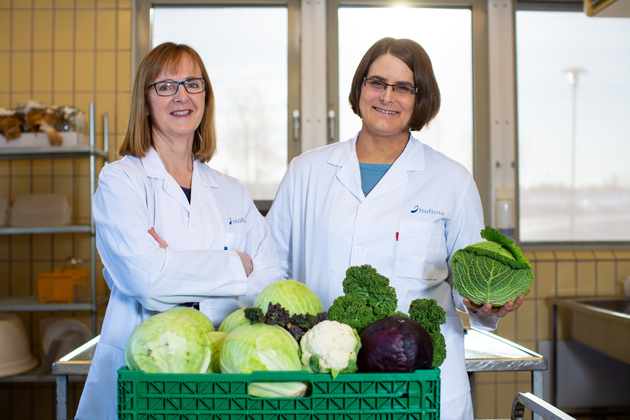Cabbage gives you choices you may not have known about

Cabbage is not just one vegetable, but a multitude of types, flavors, colors, shapes and sizes, and the industry has much to gain from exploiting this diversity. Nofima scientists have studied more than 50 different cabbage cultivars and found significant differences in taste, texture, content of aroma- and plant health-promoting compounds.
For the food industries, this means new opportunities to grow, sell and market cabbage.
The scientists examined cabbage, both the most widely cultivated cultivars, as well as new and less commonly used cultivars. Among the cultivars, some were mild and crisp, while others were flavorful and robust. Savoy cabbage and red cabbage top the list when it comes to healthy plant compounds and aroma.
Head cabbage provides benefits all year round
In addition to the fact that cabbage is healthy and can be prepared in a multitude of ways, cabbage crops thrive in the Norwegian climate and there are cabbage cultivars that can be cold stored for a long time. This means that Norwegian cabbage can be offered all year round and contribute to increased self-sufficiency.
There are many cultivars of cabbage that can be grown throughout the year. They include spring cabbage, autumn cabbage and winter cabbage, and mainly differ in how long they take to reach harvest maturity. Within each season, there are both mild and more flavorful cultivars. Some have a mild, sweet taste, while others offer a more pronounced, stronger flavor – for example, with more peppery notes or bitterness, and a distinct green aroma. Other cultivars are more acidic and crisper.
Big differences provide new opportunities
The wide diversity among cabbage cultivars allows producers, wholesalers and retailers to offer products tailored to different uses – from raw cabbage products and salads to ready-to-eat meals and pickled or fermented products.
“We have proposed a clearer differentiation that can help consumers choose cabbage based on both taste preferences and intended use. There needs to be greater awareness of how much variation actually exists. We have documented both the external and internal qualities of the cultivars, and thus provided a strong foundation for product differentiation,” says senior scientist Grethe Iren Borge at Nofima. She has led the CabbageTaste project.
Advanced analyses provide new knowledge about cabbage
The researchers used advanced chemical analyses (metabolomics) to map compounds down to the molecular level. At the same time Nofima’s sensory accessors evaluated and grouped the cabbage cultivars according to sensory characteristics, such as appearance, flavor and texture. This approach provided a unique insight into both the visible and “invisible” qualities of the cabbage cultivars grown in Norway. The results are documented in the Nofima report Increased value creation for Norwegian cabbage crops.
“We have analyzed health-relevant plant compounds,aromatic compounds and sensory properties in all the cabbage cultivars. Together with assessments of the cabbage’s growth characteristics – such as tolerance to cracking and inner stem length – we provided recommendations on which cultivars are best suited for different purposes, both for industry and consumer,” says Grethe Iren Borge.
The pointed cabbage Cape Horn as an example
The analysis of the cultivar ‘Cape Horn’ shows how the researchers have worked. This pointed cabbage cultivar is ready for early harvest and develops vigorous, healthy plants with a short inner stem and loose-leaf structure. The sensory panel described the cabbage as crispy and juicy, with a mild, fresh, green taste. “Cape Horn stood out with a distinct floral smell. Our chemical analyses confirmed this: It had high levels of aromatic compounds that contribute to floral and green aroma, and few of the compounds that give a burning, peppery taste,” says Nofima scientist Gesine Schmidt.
She adds: “By linking sensory assessments with detailed chemical analysis, we gain a deeper understanding of the complex aroma profile in cabbage cultivars.”
Taste and health – hand in hand
Cabbage contains many different types of plant compounds, including glucosinolates, which are healthy sulfur-containing compounds and can give cabbage a peppery taste and a stronger, slightly pungent aroma. Cultivars with a low content of glucosinolates therefore taste milder. Mild cultivars have a lower content of health and aromatic compounds, while red cabbage and savoy cabbage have a particularly high content of healthy plant compounds such as glucosinolates and polyphenols (antioxidants).
Fresh Norwegian cabbage is also a good source of vitamin C. Raw cabbage provides the greatest health benefit, as cooking reduces vitamin C.
Facts about the research
he research has been carried out in the four-year project CabbageTaste – Increased value creation of Norwegian Brassica vegetables – mapping sensory quality and plant compounds to improve consumer choice. The project was funded by the Research Funds for Agriculture and Food Industry (FJM). The knowledge gained from the project can help consumers, producers and retailers choose and use several types of cabbage.
Nofima led the project, other partners were: NIBIO (Norwegian Institute of Bioeconomy), Norwegian Agricultural Advisory Service, BAMA Gruppen AS, Gartnerhallen SA and their producers, NORGRO AS, LOG AS and Fraunhofer IVV (Germany).
The field trials were carried out within commercial cabbage fields kindly hosted by the following growers: Karine Huseby (Tjølling), Ihla Samdrift (Lier), Anders Hørthe (Sylling), Edvard Dahl (Stange), Per Odd Gjestvang (Toten) and Roy Hasle (Rygge)
You can read more about this research in the following reports (in Norwegian, summary in English):
Scientific publication:
Topics
Vegetables
Research facilities

